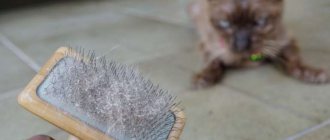What will you learn from the article?
- Where does a cat get worms?
- Symptoms
- Types of worms Tapeworms (cestodes)
- Roundworms (nematodes)
- Flukes (trematodes)
- Medicines for helminths
Helminths (worms in cats) are a very common parasitic disease that can pose a serious threat to the health and life of a pet. From this article you will learn what to do in case of helminthiasis, how to deworm (what anthelmintic drugs to give) and, most importantly, how to prevent your cat from becoming infected with parasites.
Where does a cat get worms?
Worm larvae and adult parasites are found in the environment: in the soil, on the grass, in water bodies. Therefore, it does not mean at all that if your cat is an indoor cat and does not go outside, then he cannot become infected with worms. You yourself can bring the larvae on the soles of your shoes or on your clothes.
Other sources of infection:
- when your cat eats raw fish, meat, or tap water;
- when fleas appear, there is a possibility of your pet becoming infected with worms;
- upon contact with sick animals, contaminated objects (sand, soil) and feces;
- Intrauterine infection of kittens from a pregnant cat is possible.
What to do at home
After visiting a doctor, you need to purchase the medications prescribed by him as soon as possible and begin treatment. In no case should you select anthelmintic suspensions or tablets on your own, since they all have different effects depending on the type of parasites and their habitat.
The deworming product should be designed specifically for kittens. This is due to the fact that drugs for adult animals have a different dosage, and sometimes a composition that a small pet may not be able to withstand.
After correct and successful selection of the medicine, treatment should be started immediately. The kitten should be given the product in the amount recommended by the doctor or as indicated in the instructions. The drug is often used with meals.
Also, for faster and more successful treatment, the following rules should be followed:
- provide your pet with a quiet, warm place to rest;
- ensure constant access to fresh boiled water;
- wash the animal with anti-flea shampoo.
Symptoms
- The presence of fleas is a direct sign of the appearance of worms in a cat.
- Invasive parasites can live not only in the intestines, but also in the bronchi, muscles, and liver, so a number of symptoms may be observed indicating the presence of helminths:
- general exhaustion of the body;
- dull coat;
- lethargic state of the pet;
- refusal of food or, conversely, increased appetite;
- thirst;
- weight loss;
- vomiting and diarrhea (the presence of parasites can be seen in vomit or feces).
- Small rashes around the anus.
- Kittens have swollen bellies, very pale mucous membranes (due to anemia), an upset stomach is replaced by constipation, bloody diarrhea.
Cucumber tapeworm
It is one of the most common types of parasitic cestodes found in both cats and dogs. The Latin name of the parasite is Dipylidium caninum. It is believed that in our country about 13% of pets have this “guest” in their intestines. The tapeworm uses peculiar chitinous hooks to attach to the intestinal wall. An adult worm in a cat’s body rarely grows more than half a meter in length (one and a half meter parasites are often found in dogs). The tapeworm got its name from its mature segments.
They are very similar in appearance to cucumber seeds. If you suddenly begin to find such “seeds” in your home in the middle of winter, we strongly recommend that you immediately show your pet to a veterinarian. It's probably time to treat the cat. Each segment, by the way, contains up to 20 parasite eggs. In this regard, the cucumber tapeworm is a very “modest” worm, since other parasitic cestodes can contain hundreds of eggs in a single segment.
When such a “container” goes out into the external environment, it dries out for some time, and the outer shell is dehydrated. The “prepared” segment has a golden color. Both in the process of crawling and during “ripening”, it literally squeezes out eggs from itself, which are distributed in the external environment.
Is there any predisposition to this disease? It is believed that cats of all breeds and ages are affected, but in practice it turns out that parasites are most often found in the bodies of the oldest and youngest pets. Their immune system is no longer able to adequately respond to all threats emanating from the external environment, and therefore the worm has a greater chance of growing to adulthood.
Types of worms
The following types of worms parasitize cats. Each type has its own symptoms and routes of infection.
Tapeworms (cestodes)
Long and flatworms can reach a length of up to 70 cm. The body of these worms consists of many segments, in each of which larvae mature.
When the larvae mature, they separate and come out together with the feces, while the segmented body of the parasite grows continuously, and new segments with larvae appear to replace the separated segments.
Routes of infection
Cats become infected with this type of worms by eating raw meat and fish. Stray animals often become infected with cestodes by eating rats or mice. Infection through larval carriers, fleas, is also possible. Helminths parasitize the walls of the cat's small intestine.
Signs of tapeworm infestation:
- changes in the pet’s body weight (the weight either increases sharply, or the cat, on the contrary, rapidly loses weight);
- change in appetite (the cat is insatiable or, on the contrary, refuses food);
- large, “inflated” belly;
- hair loss;
- Excessive licking in the anal area.
Why are they dangerous?
The cat's gastrointestinal tract becomes clogged with worms, causing intestinal obstruction. Possible death.
As you can see
It is very common to see tapeworm segments around the anus of a sick animal - these segments resemble grains of rice or sesame. Also, individual parts of cestodes are found on the animal’s bedding. In a more severe form of worm infestation, parasites can be seen in the vomit.
Roundworms (nematodes)
The most common type of internal parasites that infect cats. There are many varieties, but the most common in our pets are roundworms. In appearance, the parasites resemble spaghetti, which is where the name “round” comes from. The length of roundworms usually reaches 5 cm, but longer individuals are also found.
Routes of infection
Kittens can become infected with roundworms through their mother's milk. The danger of infection lies in wait for an adult cat when eating rodents, raw meat and in contact with an infected animal.
Signs of roundworm infection:
- weight loss;
- enlarged belly;
- vomit;
- diarrhea;
- general weakness.
Why are they dangerous?
Worms accumulate in the small intestine, injure the gastric mucosa, and can clog the bile ducts and intestines. They can parasitize almost all organs of the animal, having a strong toxic and allergic effect on the body.
As you can see
With intense helminthic infestation, nematodes can be seen in sputum after coughing or in vomit. Roundworm eggs can accumulate in the folds around the animal's anus.
Flukes (trematodes)
Parasites that can be localized anywhere: in the gastrointestinal tract, liver, bile ducts, respiratory organs. These are flatworms with suckers, with which they are firmly attached to the tissues of internal organs, most often the liver. With these suckers, hermaphrodite worms attach to the tissues of the cat's internal organs, eating and destroying them.
Routes of infection
Infection occurs by eating raw fish, seafood or through raw water.
Symptoms of fluke infection:
- cough;
- dyspnea;
- jaundice;
- vomit;
- weight loss;
- diarrhea;
- painful stomach;
- depressed state.
Why are they dangerous?
The activity of parasites disrupts the patency of the bile ducts, causing cirrhosis and liver failure. This can cause lethargy and death.
As you can see
The moving parts of the flukes can come out through the cat's anus. If you look closely, you can see tiny translucent parts of the parasite around the animal's anus, on its bedding.
First aid
Severe symptoms may occur in the evening when veterinary clinics are closed.
The pet owner can provide first aid independently.
- The predator is given plain water (not by force). The liquid will help remove residual toxic substances and relieve spasm of the intestinal muscles.
- Refuse to feed, especially dry food. Food provokes attacks of nausea. A predator may choke on pieces of food.
- Sorbents are given to block the action of toxic substances; activated carbon (1 t/kg) or Phosphalugel (0.5-1 mg/kg) are suitable.
Be sure to read:
How many days before vaccination should a cat be given anthelmintic: why, how to do it correctly, the best remedies
As soon as the pet's condition improves, it is taken to the veterinarian.
Diagnostics
A final diagnosis can only be made by a veterinarian after studying the anamnesis and taking the animal’s feces and blood for analysis. A stool sample is collected for three consecutive days to rule out a “false negative diagnosis.”
If the owner notices particles of worms in the cat’s feces or on the animal’s body, then this should also be reported to the veterinarian.
Important!
Please note that parasite larvae may persist in the milk of nursing cats. Therefore, even if the mother cat has a negative test for worms, it is necessary to carry out thorough anthelmintic therapy for the babies.
Possible complications
A late visit to the doctor or incorrectly selected self-medication threatens the kitten with serious complications that can lead to death or severely weaken the pet’s immunity for life.
Parasitism of helminths on any organs also causes mechanical damage. As a result, internal bleeding or ulcers may occur.
Dead worms, decomposing, contribute to intoxication of the body and its internal poisoning.
Also, helminths often cause intestinal blockage and, in advanced cases, rupture.
Antihelminthics for cats
Anthelmintic drugs are prescribed for medicinal purposes by a veterinarian after all tests have been carried out, the type of parasites, the location and degree of helminthic infestation have been determined.
The doctor must select the brand and form of a targeted drug that acts on a specific type of worm. Or prescribe a medicine with complex action if the cat is infected with several types of helminths or the type of worms could not be determined.
For the purpose of prevention, anthelmintic drugs for cats are prescribed 2-4 times a year. It is mandatory to carry out antiparasitic treatment before mating, before vaccinations and simultaneously with anti-flea drugs.
Medicines for helminths
In veterinary pharmacies, anti-worming drugs for cats with targeted and complex action are widely available in various forms of release:
- Drops on the withers are the most popular products, characterized by quick action and ease of application. The drops are applied to the withers and between the animal's shoulder blades - there is no need to force the cat to drink the bitter medicine.
- Profender (Bayer) - price in Russia for 1 pipette 350-450 rubles / in Ukraine 110-230 UAH);
- Dironet Spot-on (Agrovetzaschita) – price in Russia 350 rubles / in Ukraine 160 UAH.
- Stronghold (Pfizer) – price in Russia 1150 rub. / in Ukraine 550 UAH.
- Anti-worm tablets - given to the animal along with food or “in its pure form”. Preparations with high effectiveness of a complex and targeted (for one type of worm) remedy. Individual selection is possible taking into account the type of parasites, the degree of infestation and the condition of the cat.
- Kanikvantel plus - price in Russia 195 rubles / in Ukraine 70 UAH;
- Enwire - price in Russia 165 rubles / in Ukraine 78 UAH;
- Drontal (Bayer) – price in Russia 320 rubles / in Ukraine 179 UAH;
- Milbemax – price in Russia 330 rubles / in Ukraine 145 UAH;
- Pratel - price in Russia 38 rubles / in Ukraine 6 UAH;
- Trontsil - price in Russia 215 rubles / in Ukraine 15 UAH;
- Febtal – price in Russia 150 rub. / in Ukraine 71 UAH.
- Suspensions or pastes are given to the animal orally using a dispensing syringe. It is convenient to dose and give to cats that refuse to eat tablets.
- Prazicide for adult cats - price in Russia 108 rubles / in Ukraine 45 UAH;
- Prazicide sweet suspension for kittens - price in Russia 127 rubles / in Ukraine 38 UAH.
- Sugar cubes - given to the animal as a treat, with food, or dissolved in water and fed to the animal through a syringe. Animals willingly eat the medicine.
- Polyvercan - price in Russia 605 rub. / in Ukraine 310 UAH.
How to use an anthelmintic drug correctly
- modern drugs for preventive purposes are given once in the morning, a preliminary fasting diet is not required;
- when treating worms in a cat, the drug must be given again after 10-14 days;
- before each vaccination, it is necessary to give antihelminthic drugs 10-15 days before the expected date of vaccination;
- you also need to give antihelminthic drugs 3 weeks before childbirth and 3 weeks after;
How to deworm kittens
- It is not recommended to give anthelmintic drugs to kittens younger than 8 weeks;
- kittens are dewormed for the first time at the age of 2 months, when the body is stronger and can perceive the toxic substances of anthelmintic drugs;
- the drug is chosen on the recommendation of a veterinarian, the dosage is calculated based on the age and weight of the kitten;
- repeat the procedure 10-14 days after the first dose.
Folk remedies
Traditional medicine for worms in cats does not have proven effectiveness and is presented in the article for informational purposes.
- Give a decoction of chamomile or fennel to drink instead of water.
- Cut the onions into 4 parts and pour a glass of warm boiled water. Give your cat this water to drink in the morning on an empty stomach for 7 days.
- Common tansy. Pour 1 tablespoon of flowers with a glass of boiling water and leave for 1 hour, then strain. Give the cat this infusion 2-3 times a day, then feed it no earlier than 30-60 minutes later.
- Alcohol tincture of wormwood is used 10 drops 2 times a day. Feed the cat no earlier than every 30-60 minutes.
- Carrot juice enemas (20 ml) once a day for a week.
Treatment of helminthic infestation
All helminthiases are harmful to health. Even when there are no obvious symptoms, parasites poison the body, cause allergies, reduce immunity, and, according to many doctors, shorten life expectancy.
At the first suspicion of helminthic infestation in a person, you need to go to the clinic, get tested and undergo an examination. After examination by a veterinarian, the pet is given a complex remedy. People are prescribed:
- a targeted drug that kills worms of a certain type;
- antihistamines to suppress an allergic reaction;
- sorbents to eliminate intoxication during mass death of parasites.
Echinococcosis requires surgical intervention - the cysts are removed, sometimes with a fragment of the affected organ. For alveococcosis, chemotherapy with anthelmintic drugs and removal of nodes are indicated. Toxocariasis is treated with courses until complete recovery.
Prevention
The disease is easier to prevent than to treat, and therefore, to minimize the risk of your cat getting worms, do the following:
- Preventive use of antiparasitic drugs for fleas, ticks, and worms once every 3 months. First we use anti-flea products, after 3 days - against worms.
- Do not feed the animal raw meat, drink only boiled/settled water.
- Avoid contact with street animals.
- Regularly carry out antiparasitic treatment of the cat's place and scratching posts. Keep your cat's grooming supplies clean.
- Clean your house/apartment regularly and take off your shoes in the hallway.
Important!
Remember that most of the helminths that infect cats are also dangerous for humans, so if your pet is found to have parasites, worry about your health too.
Owner stories
Sofia: “We adopted a cat from a shelter. It turned out that the cat had worms. Moreover, there were a lot of them, all the feces were strewn with larvae and parts of parasites, such small white things. We suffered with her until the veterinarian advised us this treatment regimen: Kanikquantel suspension three times with an interval of 2 weeks. We're doing well now."
Tamara: “My son brought a kitten from the street. I immediately realized that the cat had worms - the baby’s tummy looked like an inflated balloon. Poor thing, he suffered while he was a wanderer. The veterinarian said to give Prasitab tablets. One tablet is designed for an animal weighing 4 kg. I gave a little less than half, crushed it into powder and diluted it with water. This mixture was poured into the baby using a syringe without a needle.”











